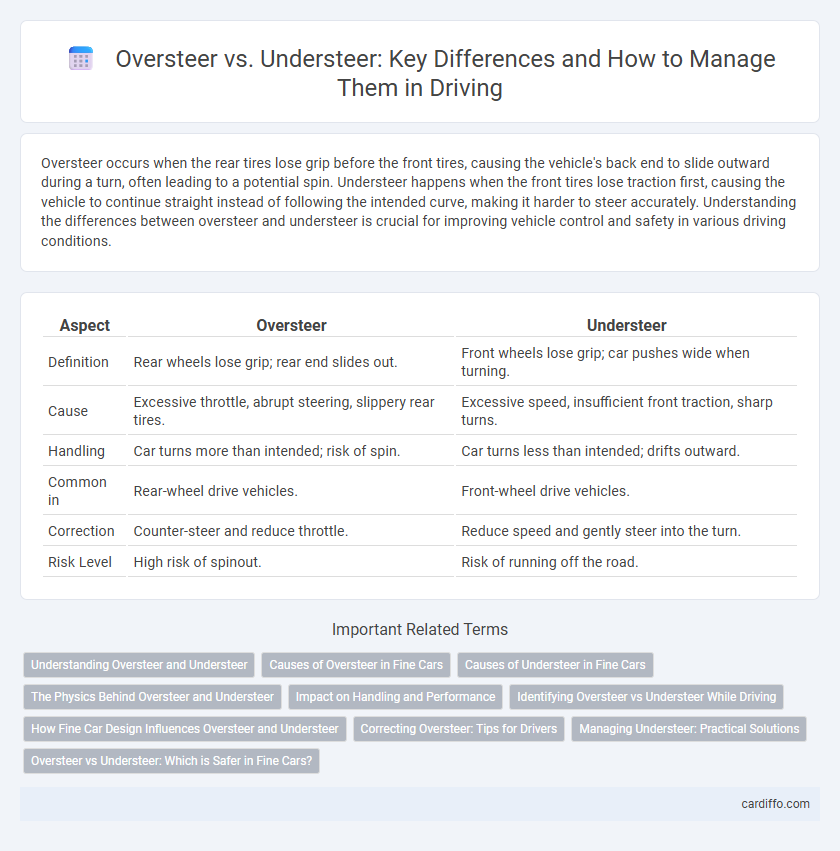Oversteer occurs when the rear tires lose grip before the front tires, causing the vehicle's back end to slide outward during a turn, often leading to a potential spin. Understeer happens when the front tires lose traction first, causing the vehicle to continue straight instead of following the intended curve, making it harder to steer accurately. Understanding the differences between oversteer and understeer is crucial for improving vehicle control and safety in various driving conditions.
Table of Comparison
| Aspect | Oversteer | Understeer |
|---|---|---|
| Definition | Rear wheels lose grip; rear end slides out. | Front wheels lose grip; car pushes wide when turning. |
| Cause | Excessive throttle, abrupt steering, slippery rear tires. | Excessive speed, insufficient front traction, sharp turns. |
| Handling | Car turns more than intended; risk of spin. | Car turns less than intended; drifts outward. |
| Common in | Rear-wheel drive vehicles. | Front-wheel drive vehicles. |
| Correction | Counter-steer and reduce throttle. | Reduce speed and gently steer into the turn. |
| Risk Level | High risk of spinout. | Risk of running off the road. |
Understanding Oversteer and Understeer
Oversteer occurs when the rear tires lose traction before the front tires, causing the vehicle's rear to swing outward during a turn, leading to a potential spin. Understeer happens when the front tires lose grip first, causing the vehicle to continue straight instead of following the intended curve. Understanding the dynamics of tire traction and weight distribution is essential for controlling oversteer and understeer in performance driving.
Causes of Oversteer in Fine Cars
Oversteer in fine cars primarily results from excessive rear tire slip caused by high lateral G-forces during cornering, often amplified by abrupt throttle inputs or sudden steering corrections. Rear-wheel drive systems and powerful engines increase the likelihood of oversteer by transferring torque to the rear axle, leading to loss of rear traction. Additionally, factors such as rear suspension geometry, tire pressure imbalance, and road surface conditions contribute significantly to the onset of oversteer in high-performance vehicles.
Causes of Understeer in Fine Cars
Understeer in fine cars primarily stems from insufficient front tire grip, often caused by excessive speed in corners or worn tires reducing traction. Front suspension geometry issues, such as improper alignment angles like toe or camber, also contribute to understeer by limiting the front wheels' ability to respond accurately to steering inputs. Additionally, front-heavy weight distribution and incorrect tire pressure can exacerbate understeer, diminishing the vehicle's overall cornering performance.
The Physics Behind Oversteer and Understeer
Oversteer occurs when the rear tires lose traction before the front tires, causing the vehicle's rear to swing outward due to centrifugal force during cornering. Understeer happens when the front tires lose grip first, resulting in the vehicle continuing straight instead of turning as sharply as intended. The balance between lateral tire forces, weight distribution, and suspension geometry critically influences whether a car experiences oversteer or understeer.
Impact on Handling and Performance
Oversteer reduces vehicle stability by causing the rear tires to lose traction, leading to sharper turns but increased risk of spinouts, affecting precision in handling. Understeer causes the front tires to lose grip, resulting in wider turns and reduced cornering ability, which diminishes steering responsiveness and overall control. Managing the balance between oversteer and understeer is crucial for optimizing vehicle performance and ensuring driver safety in various driving conditions.
Identifying Oversteer vs Understeer While Driving
Oversteer occurs when the rear wheels lose traction, causing the car's rear to swing out, while understeer happens when the front wheels lose grip, making it difficult to turn the car as intended. Drivers can identify oversteer by feeling the vehicle's back end sliding outward during a turn, and understeer by noticing the car pushing wide and the steering feeling less responsive. Correctly recognizing these behaviors allows drivers to adjust throttle, steering input, and braking to regain control and maintain safe cornering.
How Fine Car Design Influences Oversteer and Understeer
Fine car design critically influences oversteer and understeer by optimizing weight distribution, suspension geometry, and tire selection. Precise calibration of the suspension system and chassis rigidity improves handling balance, reducing excessive rear or front wheel slip during cornering. Advanced aerodynamic features also enhance downforce, stabilizing the vehicle and mitigating oversteer or understeer tendencies.
Correcting Oversteer: Tips for Drivers
Correcting oversteer requires precise countersteering to regain vehicle control and prevent spinning. Drivers should gently ease off the accelerator while smoothly turning the steering wheel in the direction of the skid to stabilize traction. Maintaining calm input and avoiding abrupt braking helps restore grip and safely maneuver through the curve.
Managing Understeer: Practical Solutions
Managing understeer involves techniques such as reducing speed before entering a corner and smoothly easing off the accelerator to regain front tire traction. Adjusting tire pressures and ensuring proper suspension alignment can enhance grip and responsiveness, helping prevent the front wheels from losing traction. Advanced solutions include using electronic stability control (ESC) systems that selectively apply brakes to the inner rear wheels to correct understeer.
Oversteer vs Understeer: Which is Safer in Fine Cars?
Oversteer and understeer significantly impact vehicle control and safety in fine cars, with understeer generally considered safer due to its predictable behavior, where the car tends to plow straight ahead, requiring less complex corrective steering. Oversteer causes the rear wheels to lose traction, leading to potential spinouts that are harder to manage, especially at high speeds or on slick surfaces. Fine cars equipped with advanced stability control systems can mitigate the risks of both, but drivers benefit from understanding that understeer allows for more controlled and safer responses during emergency maneuvers.
Oversteer vs Understeer Infographic

 cardiffo.com
cardiffo.com